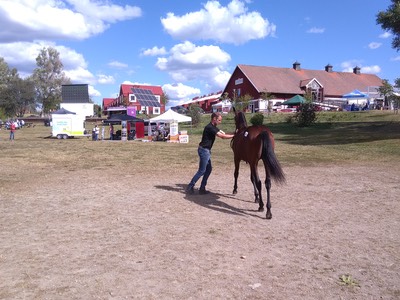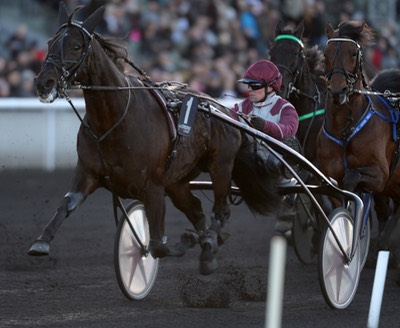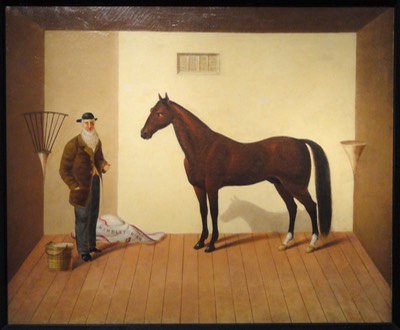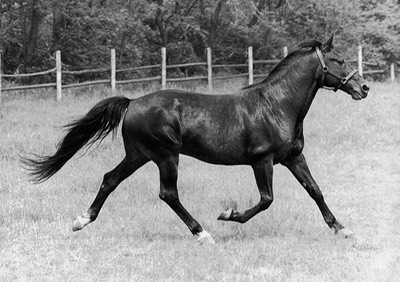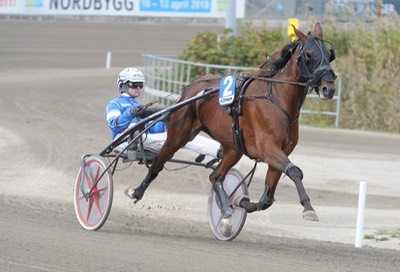"If there were no experimentation on the Turf,
nothing would have changed
since Eclipse." Federico Tesio.
“In the field of opportunity, it’s plowing time again." Neil Young.
Ahead of Deauville, beyond Lexington, Ulf Lindström covers the big picture, from 1704 to 2020 in his reflection on the sport and breeding industry. Harmonization across jurisdictions to reach for excellence, or each turf by and for itself into oblivion? Political as well as equine cross-overs have prevailed, will prevail in trotting.
Muscle Hill winning the Hambletonian 0f 2009. Foto: Gerard Forni
Propulsion's race in the Aberg Memorial (1:08.1/1:49.3) sent pundits over the edge to land atop those who had already been pulled over by Bold Eagle's last 200 meters in the Elitlopp elimination, a finish said to herald a new breed!
Off-pist, in the sales ring, Ready Cash, 12, weighing in at 4,282,300€ and Muscle Hill, 11, weighing in at $3,273,342 are the leading contenders as World Champion of Trotting Sires. Rocky Balboa and Ivan Drago are back, heavier perhaps but twice as fleet-footed!
Throwing up his hands, an American trainer thought he'd put the issue to rest, "If you want to win the Hambletonian you need a colt by Muscle Hill." It didn't help against Perfect Spirit's "old" blood - and no Valley Victory too - but his daughters Ariana G and Manchego and son You Know You Do saved the day in the Oaks, Jim Doherty/Merrie Annabelle and Peter Haughton Memorial, respectively.
Courant Stable paid $350,000 for a Muscle Hill colt (out of Naga Morich) at the Kolgjini sales in July, all-time high for a yearling born and registered in Sweden. Two weeks later at the Berlin yearling sales, the Bold Eagle colt Matchpoint Pellini (out of a Yankee Glide mare) set a new European sales record at 360,000€. Buyer? The seller of the aforementioned colt and owner of the winner of the Hambletonian. The Wenngarn sales outside Stockholm in mid August saw Ready Cash, and especially his son Bold Eagle, gaining on Muscle Hill. This spirited Bold Eagle colt, out of a mare by Varenne, was the top seller at 150,000€.
For the select human tribe of the trotting industry it's now off to the Lexington sales, October 3-7, by way of Deauville, France, September 6-8 to check out the 14 lots by Ready Cash and 22 lots by Bold Eagle. For us "armchair buyers," short on funds, it's reflection time again.*Recurrent outcrossing reduces the risk of hereditary diseases in the Standardbred stock. Yet, North American harness racing, in partial contrast to European, is wary of new blood in the breeding barns. The industry is indeed concerned, like our fellow "armchair breeder" in Canada:
"If she [Mission Brief, by Muscle Hill] were mine, which she obviously isn't, I'd try to breed her to the great French stallion Ready Cash, the sire of arguably the greatest trotter in the world, Bold Eagle. The resultant foal would generate more world wide interest than that of any trotting yearling ever. Not only that, but it would have the genetic potential to be a breed changer. If that wouldn't, I cannot think of a potential mating that would.“Don’t despair, sir/ma’am. Isn't cross-breeding a godsend ever since Darley's Arabian was shipped from the Levant to land at Kinsale, County Cork in 1704 and his descendant Messenger careened off the ship at Philadelphia in 1788? Fine, but let's fast forward to phrase the question in both academic and pecuniary terms:
What would you do as proud owner of a three-year-old filly after she's won two or three of the black-type U.S. trotting stakes to end the year as number 6-20 in earnings? (Top five and it's a foregone conclusion.) Pondering who to breed her to among the roster of stallions available next season, what'd be the best return on investment? (In case you opt for campaigning her as a four-year-old you're most likely European and thus excused as an unorthodoxy in the industry.)
For a fine-looking colt by Muscle Hill? Eighteen months later you'll be looking at $350,000 at the Lexington sales. Chapter Seven and his son Walner? Depends, $200.000? For a colt by a Franco-European champion sire?
He'll draw curious inspections as a novelty, all right. Polite accolades all around. Still, you'd be lucky to hear six-digit bids from American customers. A lukewarm reception at the last hammer may hurt the mare's future record as dam and granddam. Not just birds of a feather flock together; expensive yearlings tend to gather at the farms of celebrated trainers to be nominated for the high-profile stakes for two-year-olds. Early speed rarely comes with a French accent. So, for semen brought across the Atlantic your return on investment is at the mercy of European buyers who could just as easily find horseflesh of similar pedigree closer to home (cf., Matchpoint Pellini).
Too few to qualify as 'consumers' in any meaningful sense, European 'players' have the sufficient means (read: a tenth) of making Standardbred sales in America as erratic as Middle East players make Thoroughbred sales: money's no object, it's mostly just for kicks.**
Overseas customers - unlike players - have to balance the cost of staking against airlifting the colt back home, about $8,000. That's a tolerable expense. But to be shut out of the national stakes up till and including his fourth, sometimes fifth, year of age? That's outright dispiriting. Add sex to the calculus. Horses and geldings, depending on age, carry a nominal penalty sum of earnings at entry to Sweden. If gelded the colt is not admitted to Norway. In short, overseas customers are well adviced to consider two well-bred fillies for the price of one colt - or hold out until Harrisburg for a young broodmare in foal to a son of Muscle Hill? Domestic regime hassle applies to all imports, French for sure and, what more, with repercussions for the entire transnational traffic in bloodstock.
Also, though the risk is low - fortunately all 20 of the foals by Love You, Sebastian K. and Ready Cash born 2017 at Lindy Farms and Hanover Shoe Farms are listed as bay - chestnut foals in the U.S. are welcomed with "ooops, sh..!" Already light bay and yearlings with plenty markings are not to the liking of the North American market. Indeed, "many 'myths' in the form of unsubstantiated opinions, ingrained misconceptions, and other falsehoods, float around the sales scene and create inefficiencies in the marketplace." Jurisdictions, even state borders in the U.S., Canada and Oceania and national borders in Europe, underpinned by cultural bias, come with hefty transaction costs in the equine business.
# Bottom-line? La patrie! It used to be different.
For decades from the mid 19th century horsemen were freely dispensing views on the choice of sires, approvingly or astounded by the chutzpah of their peers. But, then, the breeders were in a similar spot as the polar explorers, restless to be the first to fame and fortune. No routes and detours were ruled out. Rumors had to be confirmed or refuted that the North Pole had a green oasis in the middle, in which center a big sinkhole opened to drain water down to the South Pole.
Mr Jonas Seeley, the owner of Charles Kent Mare, may as well have bred his mare to Boston (thoroughbred, b. 1833 by Timoleon) and we'd been cheated on Hambletonian. Mr Rysdyk, the stable hand who bought the colt, laughed all the way to the bank (dropping in at the barber and tobacconist) where his account for stud fees for Hambletonian amassed $200.000, equivalent to $3.5 million today. For his part, the owner of Princess (by Hamiltonian) perhaps saw a divine sign in the name 'Hambletonian'? His mare, or his wife's, was basically a Thoroughbred. Anyway, Happy Medium was born in 1863, the sire of Nancy Hanks. Without her we'd be missing a lot of today's top performers in all corners of the harness racing world.
Meanwhile, throwing trotting talent to the Pacific wind, big players like Mr Leland Stanford persisted in breeding his mares to Thoroughbreds. At his Palo Alto farm, some 700 head at peak stock, average sulky horses were produced until the acquisition of Electioneer (b. 1868, bought for $12,000 in 1877**). Shipped from the East Coast on Stanford's railroad, Electioneer was to add a patrilineage of insult to injury, the Senator being of the opinion that "no gentleman drives a pacer.“
The ending of the explorative years of breeding, the entrenchment of conventional breeding, came with the parting of trotters and pacers. Volomite in and by himself was a fork in the road. His first offspring were born in 1930. Throughout his stud career trotters and pacers were equally successful. Sweden still honors his son Bulwark (b. 1933) as the founding sire of her sport. Volomite's last crop was born 1951, to whom Phantom Lady bagged one heat in the Little Brown Jug.
Conventional breeding says 'return to the sire the best blood of his dam' or just 'breed the best to the best and hope for the best.' No foolproof road to success; like the Lego Dilemma "all pieces need to fall into place" too. They sometimes do, even among offspring to less than blueblooded material. All nations have their stories, this is Austria’s:
In the market for upgrading its stud service, the Vienna Trotting Association was keen on sons of Star's Pride. Proud Vic (b. 1963), pony-sized and expensive may have cost the board of governors their seats if it weren't for the seller throwing in an extra stallion: Proven Freight (b. 1964 by Hickory Smoke). Both started their duty in 1973. Amazingly, the back-up Proven Freight produced good racehorses out of nearly every dam. With 640 offspring to his name, among them three Derby winners (Brubaker, Dale Qui and Boris Freight), he was also the damsire of three Derby winners. At the fixed fee of 730€, Proven Freight turned out to become the most successful stallion import in Austrian trotting history. Proud Vic? He supplied the dam material for Proven Freight, the 3x3 line-breeding to Star's Pride a boost to the Austrian stock.
In Germany, the then famous Stall Lucky Kotten, owner of Königskrone (b. 1976, by Arden Al), probably injured at 3 or 4 whose mother had won the European Championship for five-year-olds, came to the right conclusion. When in doubt, book a first season stallion. Super Way (by Super Bowl), was a rookie. His first crop, 1982, saw Diamond Way. Mr Alwin Schockemöhle bought the colt at two. Having gained 730,000€ at the track, Diamond Way won eighteen straight German sire championships. Super Way went off to become a dud at stud. Out of 308 offspring three earned more than 100,000€; of Diamond Way's eight full siblings two were entered in a race, none won. The maternal line is now in a delicate state, left with Finland's Annie Outlaw, winner of the 2009 national Oaks.
Leapfrogging advances in the sport through breeding - creating buzz that pales the breaking of records by the "Bubka-One-Centimeter-at-a-Time-Trick," to produce horses with straight wins to be challenged by local heroes, trotters making the cover of renowned magazines - have two future options only: French or pacer blood. (The fruits of applied genetics such as 'genetic drift,' 'expected progeny differences' (EPD), DMRT3, etc., are inaccessible to laypersons.)
Wishful thinking is futile. While his head adorned Time magazine, Secretariat's heart - 10 kilograms as opposed to the normal 4 - is not a heritable trait (no more than Eclipse's at his death 1789, 14 to 9lbs). His eminence as damsire notwithstanding, Secretariat's descendants don't run races that would suggest a linear correlation between time and the weigth of their hearts. Besides, forget cross-breeding to Thoroughbreds and Orlov hybrids. Forget Morgans and show jumpers with trotting blood as theoretical keys to a new breed. Progeny of these breeds are now banned from the studbooks of Europe.
Human agency is necessary to see a game-change in the bloodstock industry. For outcrossings to pacers and Trotteur Français to achieve the result on par with sires like Florestan, Valley Victory and their respective descendants Sebastian K. (as racehorse) and Ready Cash and Muscle Hill, it takes bold young breeders with staying power and money flowing both ways. (European state studs now allowed for endangered breeds only.)
If, come 2019 and 2020, the 20 "Frenchy" products by Lindy Farms and Hanover Shoe Farms slash records in North America it may, for a start, make the breeders of Standardbreds rediscover their trotters and pacers across the mental aisle of the barn (in Oceania, too). An embryonic "Gallic vouge” would pick up momentum if the industry were to allow for a few long-distance races with 16 horses behind the gate. Race cards need to become more exciting among punters too! Monté (racing under saddle) is the family friendly discipline, shrinking the gender gap and lowering the barrier between actors and spectators cum owners. Alas, unfamiliar with the rule that it takes two to tango, the French would not be forthcoming to reciprocate even with a repeat of the select breeding slots of the 1980s. What if the 20 don't make headlines?
Unorthodox breeding of consequence, unlike random shots in the dark, is feasible in France and Sweden only. The French Studbook, with some fourteen thousand broodmares, is opened only by political means, however. By force of number of broodmares - 3,200 annual foalings, and retaining the policy of breeders' premiums (20%) on purse money earned - Swedish breeding is the realistic alternative for cross-breeding of critical mass at affordable cost.
Recent Swedish experience of cross-breds is difficult to put into regular statistics. The total population of individuals who’d qualify as hybrids is partly a matter of definition. Available data on pedigree - restricted to first generation or grandsire/granddam - suggest a remarkable record. Gisela Ås (damsire Cambest) won the 2013 Queen Silvia’s Trophy. Eketorpets Tess (damsire Dignitarian) finished second in European Championship for Mares in 2015. (Both Gr I Int'l races.) Peignoir (b. 2008, out of pacer dam) broke Swedish record time. A fair guess says the combined number of first and second-generation cross-breds entered in Swedish races over the last ten years is less than twenty(?) If pedigrees include three generations, Ourasine (b. 1991, by French Ourasi out of pacer motherline) 6 wins from 23 starts, is the dam of three SEK millionaires, among them Jocose.
An initiative as commendable as the 20 American projects, half a dozen individuals out of pacer mares or hybrids and some thirty products by Googoo Gaagaa await their debut in Sweden. This filly, Gazelle Am (b. 2016), line-bred to Noble Victory by the Courant group, is more than welcome to upset received wisdom in the sport and, subsequently, bloodstock industry!
http://www.sophiapedigrees.com/search/1317335/standard/
Hypothetical mating suggests two examples:
http://blodbanken.nu/servlet/GetBBData?sire=426861&breed=warm&dam=653605&
Peignoir, as her dam, was bred by Menhammar Stud. Bred to the farm's own From Above the offspring would be line-bred to the mare Glad Rags and Speedy Crown (the latter appears to be the common denominator of the 2017 foals by "Sebbe" at Hanover Shoe Farms). Didn't we hear someone say 'you can't get enough of Speedy Crown'? Even better, this is no more hypothetical: Peignoir is confirmed pregnant!
The American and Swedish industry, represented by Hanover and Menhammar no less, may still join genes by line-breeding to Hoot Mon. Wise or not, this too (cf., Gazelle Am) would please the grand old mother Medio very much, not to speak of her ancestors Messenger and Darley Arabian:
http://blodbanken.nu/servlet/GetBBData?sire=426861&dam=DAGNABIT+HANOVER&breed=warm&
From Above was runner-up to champion sire Love You in Sweden in 2015. Dagnabit Hanover's second dam (granddam of Austria's Dale Qui) is by the trotter Speedy Count, sire of Delmonica Hanover, winner of e.g., Kentucky Futurity, Lady Suffolk, and Prix d'Amerique. But, like Zoot Suit, she was "only" second in the Hambletonian.
Sinkholes are to be found in all barns, eternally green pastures around the corner. Fortunately, not far off the farms transactions are taking place among horsepeople whose pockets are immensely deeper than those of Mr Rysdyk. True, money negotiates borders. But money is both a panacea against and underwriter of regimes and rules upheld by closed minds. The political economy of harness racing is defined ultimately by state rights/province rights in the Anglosphere and France's coddled position in the Union of European Trotting. Harmonization across jurisdictions to reach for excellence, or each turf by and for itself into oblivion?# Cross-overs have prevailed, will prevail.
*Follow the sales on:
http://m.arqana-trot.com/resultats/ventes-de-yearlings-selectionnes-2017
www.lexingtonselected.com
Last year the reflections turned to practical issues, how to enjoy breeding
trotters without a farm and with limited funds:
http://www.breedingtrotters.com/content-2/international/confessions-of-a-desktop.html
**Perspectives: average monthly income of American factory worker in 1880 was
$35 before tax, or 29 years to gross $12,000. For the average factory worker of
today, it would "only" require ten years of work before tax to reach
the $350,000 paid for a Muscle Hill yearling. Thoroughbred comparison: in 1984,
the dozen Northern Dancer yearlings in the Keeneland catalogue sold for an
average of almost $3.5 million. In that sense, trotting horseflesh is cheap
nowadays.
#No simple matter, in face of declining number of new-born trotters, the national breeding series (for 3 and 4 yos) of the Nordic countries may soon need to be joined into one series open for all horses born in the Baltic, Denmark, Finland, Norway, and Sweden, and perhaps northern Germany too. A joint Central European series makes sense for all horses born in Austria, Bulgaria, Czech Republic, (southern) Germany, Hungary, Romania, Serbia, Slovakia, and Slovenia. Unpleasant perhaps, such scenarios, the pros and cons, have to be moved up on the agenda of the U.E.T "Furthermore, I consider that French protectionism must be d..iscussed.”
Comments? euret@live.com
2017_08
